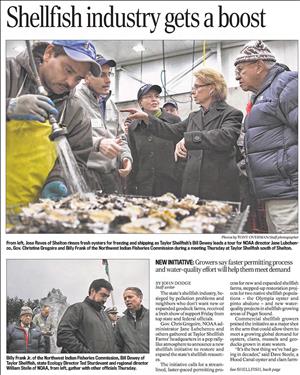On December 9, 2011, Governor Christine Gregoire announces the formation of the Washington Shellfish Initiative. Washington is the first state to implement a regional shellfish initiative following the National Shellfish Initiative, which was launched by the National Oceanic and Atmospheric Administration in June 2011. In subsequent years, Alaska, Oregon, and California will join Washington in creating shellfish initiatives.
National Initiative
The national initiative has a high-level goal of increasing populations of bivalves (particularly oysters, clams, and mussels) in coastal waters of the United States. The initiative notes that healthy populations of shellfish contribute a number of benefits, including providing habitat for a range of species, meeting consumer demand for shellfish, providing cleaner water, protecting shorelines, and creating jobs.
On December 9, 2011, Governor Christine Gregoire announced the Washington Shellfish Initiative to echo the goals of the national initiative. In a statement, Gregoire noted, "The Washington Shellfish Initiative is critically important for our citizens, our cultural and tribal heritage, and our economy and the health of our marine waters ... Wild and farmed shellfish need unspoiled water to be healthy and viable – and Washington’s shellfish growers have been advocates for clean water for more than 65 years" (news release). At the time, farmed clams, oysters, and mussels had a value of more than $107 million per year, employing more than 3,200 people, and contributing more than $270 million to the state’s economy.
The announcement of the initiative was held at Taylor Shellfish Farms in Shelton. Representatives from NOAA, the U.S. Army Corps of Engineers, local government, tribes, and the shellfish industry were in attendance, reflecting the wide range of stakeholders agreeing to help meet the initiative’s goals. Those goals include working to improve habitat for the state’s shellfish, with special emphasis on restoring native Olympia oyster and pinto abalone populations; promoting and expanding shellfish aquaculture in Washington; providing greater opportunities for recreational shellfish harvest; and focusing on improving and protecting water quality in general.
Among key developments following launch of the initiative was formation of the Blue Ribbon Panel on Ocean Acidification. Made up of scientific experts, relevant agencies, and other stakeholders, the panel was tasked with developing concise recommendations to help better understand the impacts of ocean acidification on the state’s shellfish industry, along with suggestions for actions that might help limit those impacts. The panel released its first report in November 2012, with 42 recommended actions to help address acidification. Areas of focus included reducing carbon emissions (a key contributor to ocean acidification), educating and engaging with stakeholders, and increasing ability to adapt to the impacts of ocean acidification.
When the initiative was launched, the connection between rising levels of acidity in seawater and detrimental effects on sea life had been discovered only a few years prior. The critical importance of increased attention to ocean acidification became increasingly clear. In November 2012, during her final weeks in office, Gregoire signed an executive order focused on increasing efforts to manage ocean acidification’s impact on the state’s shellfish industry. She also proposed establishment of a new research center at the University of Washington. The Washington Ocean Acidification Center opened in 2013, and among its multifaceted activities are monitoring acidification levels and the resulting impact on sea life, and providing training about the challenges posed by ocean acidification.
Another significant outcome of the Washington Shellfish Initiative was the creation of a new state-of-the-art shellfish hatchery to promote restoration of native species – with initial focus on Olympia oysters and pinto abalone. The Kenneth K. Chew Center for Shellfish Research and Restoration opened in May 2014, named for the "patriarch of shellfish research" Kenneth Chew (1933-2022), who was a fisheries professor at the University of Washington for over four decades. The center is a partnership between NOAA and the Puget Sound Restoration Fund. It is located on the Kitsap Peninsula at the Manchester Research Station, where aquaculture research has been conducted since the 1970s. John Stein, director of the NOAA Northwest Fisheries Science Center at the time of the new hatchery’s opening, was quoted as saying, "Work is underway for growing millions of native Olympia oyster larvae that will be planted in priority restoration sights around the Puget Sound later this summer" ("New Shellfish Hatcher ...").
An addendum to the 2012 Blue Ribbon Panel report was published in December 2017, documenting much of what had been accomplished since the initial report. Noted in the Executive Summary: "Alongside progress made at home, Washington state has also emerged as a recognized leader on the regional, national, and global stages in the fight to address ocean acidification. The Blue Ribbon Panel’s comprehensive strategy has inspired other coastal states such as Maine, Maryland, Massachusetts, New York, and Oregon to develop similar action plans to address and adapt to ocean acidification off their shores" (2017 Addendum).
Phase Two of the Washington Shellfish Initiative was launched by Governor Jay Inslee on January 15, 2016. This second phase continues momentum of achievements from the initial phase and incorporates updated strategies to further bolster healthy shellfish populations.

